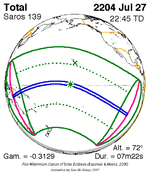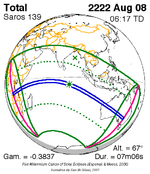Solar eclipse of July 16, 2186
| Solar eclipse of July 16, 2186 | |
|---|---|
UTC) | |
| Greatest eclipse | 15:14:54 |
| References | |
| Saros | 139 (39 of 71) |
| Catalog # (SE5000) | 9933 |
A total
This eclipse will be the longest total eclipse for several thousand years before and after it occurs. The eclipse will pass over the southern Galápagos Islands (with a total eclipse of 4 minutes occurring over the southern tip of Española Island), the northern tip of Ecuador (with a total eclipse of 3 minutes and 26 seconds on Isla Santa Rosa), central Colombia (4 minutes and 50 seconds over Bogota), central Venezuela, and northern Guyana (7 minutes and 4 seconds just north of Anna Regina).[1][2]
Extreme duration


This will be the longest total solar eclipse between 4000 BC and at least AD 6000 (10,000 years), lasting a maximum of 7 minutes, 29.22 seconds. The factors that will make this such a long eclipse are:
- The Earth being very near aphelion (furthest away from the Sun in its elliptical orbit, making its angular diameter nearly as small as possible). This occurs around July 6th.
- The Moon being almost exactly at perigee (making its angular diameter as large as possible). The moment of greatest eclipse will be just 50 minutes after perigee.[3]
- The midpoint of the eclipse being very close to the Earth's equator, where the Earth's rotational velocity is greatest.
- The midpoint of the eclipse being near the subsolar point (the part of the Earth closest to the Sun, and therefore also closest to the Moon during an eclipse).
- The vector of the eclipse path at the midpoint of the eclipse aligning with the vector of the Earth's rotation (i.e. not diagonal but due east). For solar eclipses at the ascending node (odd numbered saros) this occurs approximately 12 days after the summer solstice.[4][5]
The longest historical total eclipse lasted 7 minutes 27.54 seconds on June 15, 743 BC.[6] The longest eclipse theoretically possible is 7 minutes and 32 seconds.[7]
Responses
Michael Zeiler, an eclipse cartographer, told Live Science the 2186 eclipse "will last up to an astonishing 7 minutes and 29 seconds, very close to the theoretical limit of 7 and a half minutes."[8]
Vice magazine, musing what the "wolves feasting on the bones" of a possibly then-extinct human civilization would think, suggested the longest solar eclipse in 12,000 years would be "worth a howl".[9]
IFL Science noted that the 22nd century will be a "golden era for eclipse chasers", with the 2186 eclipse overshadowing two other 7+ minute events in 2150 and 2168.[10] No total solar eclipse of the 21st century will exceed 7 minutes.[11]
In March 2023, the art and design magazine IGNANT interviewed the Berlin-based photographer Matthias Ledinger about his project AD2186. Using primarily black and white media, Ledinger "depicts the complex awe-sensations and emotions generated by the solar eclipse" similar to that of the Overview effect.[12]
Related eclipses
Saros 139
This eclipse is a member of saros series 139, repeating every 18 years, 11 days, 8 hours, containing 71 events. The series started with partial solar eclipse on May 17, 1501. It contains hybrid eclipses on August 11, 1627, through to December 9, 1825; and total eclipses from December 21, 1843, through to March 26, 2601. The series ends at member 71 as a partial eclipse on July 3, 2763. Its eclipses are tabulated in three columns; every third eclipse in the same column is one exeligmos apart, so they all cast shadows over approximately the same parts of the Earth.
The
The longest duration of totality will be produced by member 39 at 7 minutes, 29.22 seconds on July 16, 2186.[13] After that date, the durations of totality will decrease until the series ends. This date is the longest solar eclipse computed between 4000 BC and AD 6000.[14] Saros series eclipses occur during the Moon's ascending node (a term related to our equator and polar-naming conventions).
| Series members 24–45 occur between 1901 and 2300 | ||
|---|---|---|
| 24 | 25 | 26 |
 February 3, 1916 |
 February 14, 1934 |
 February 25, 1952 |
| 27 | 28 | 29 |
 March 7, 1970 |
 March 18, 1988 |
 March 29, 2006 |
| 30 | 31 | 32 |
 April 8, 2024 |
 April 20, 2042 |
 April 30, 2060 |
| 33 | 34 | 35 |
 May 11, 2078 |
 May 22, 2096 |
June 3, 2114
|
| 36 | 37 | 38 |
June 13, 2132
|
June 25, 2150
|
July 5, 2168
|
| 39 | 40 | 41 |
 July 16, 2186 |
 July 27, 2204 |
 August 8, 2222 |
| 42 | 43 | 44 |
 August 18, 2240 |
 August 29, 2258 |
 September 9, 2276 |
| 45 | ||
 September 20, 2294 | ||
References
- ^ Total Solar Eclipse of 2186 July 16 - Interactive Eclipse Path Using Google Maps NASA Eclipse Website, Fred Espenak.
- ^ "Total solar eclipse: Here are the answers to 8 common questions". WGAL. 2024-03-28. Retrieved 2024-03-28.
- ^ "Lunar Perigee and Apogee Calculator".
- Bibcode:2003JBAA..113..343M.
- ^ M. Littman, et al.
- ^ Ten Millennium Catalog of Long Solar Eclipses, -3999 to +6000 (4000 BCE to 6000 CE) Fred Espenak.
- ISBN 978-0-19-953209-4.
"Eclipse expert Jean Meeus calculates the maximum possible eclipse duration of totality in a solar eclipse is currently 7 minutes 32 seconds.
- ^ Carter, Jamie (2024-01-31). "What's the longest solar eclipse in history? (And how does the April 2024 total eclipse compare?)". livescience.com. Retrieved 2024-03-28.
- ^ Byrne, Michael (2016-02-18). "Astronomers Discover the Universe's Longest Known Stellar Eclipse". Vice. Retrieved 2024-03-28.
- ^ "When Was The Longest Recorded Solar Eclipse In History?". IFLScience. 2024-03-15. Retrieved 2024-03-29.
- ^ Mobberley, Martin (2007). Total Solar Eclipses and How to Observe Them. New York: Springer. p. 10.
- ^ Gualandris, Devid (2023-03-25). "AD2186, Matthias Leidinger's Photographic Exploration Of Awe And Wonder". IGNANT. Retrieved 2024-03-28.
- ^ Saros Series Catalog of Solar Eclipses NASA Eclipse Web Site.
- ^ Ten Millennium Catalog of Long Solar Eclipses, −3999 to +6000 (4000 BCE to 6000 CE) Fred Espenak.
